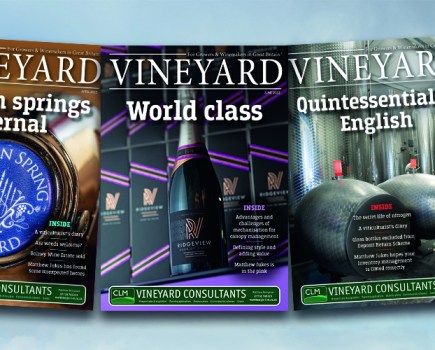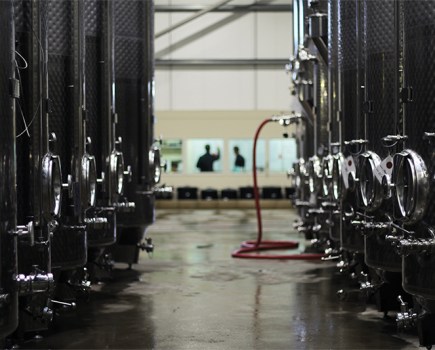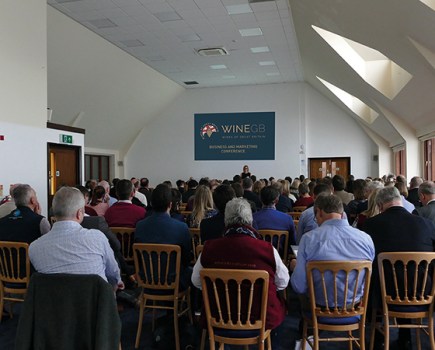Tucked away in the quirky wine cellars of The Stafford in St James’s, London, a collaborative group of English wine producers, Vineyards of Hampshire, gathered on Tuesday 6 February to showcase the region’s offering of wines to trade buyers.
Following on from the group’s successful consumer-based Hampshire sparkling wine festival, which attracted over 700 visitors last year, seven vineyards attended the third annual London tasting to demonstrate the array of distinctive styled still and sparkling wines now produced in the county.
Providing an opportunity for producers to combine resources, alongside the tasting events Vineyards of Hampshire is also keen to advance the region’s tourism appeal and is set to launch a vineyard trail in 2018. By promoting the trail on set days throughout the summer the scheme will give smaller, independent estates, who are not normally open to the public, the opportunity to provide a cellar door experience.
Cottonworth
A relative newcomer to the English sparkling wine market, having planted in 2006, the Liddell family’s vineyards span 30-acres divided across three sites near Andover.
As well as selling 65% of its grapes to other wineries, the boutique estate has 12,000 bottles of its own label sparkling wine produced by fellow Vineyards of Hampshire member Hattingley Valley. At the moment only two styles are produced, although there is a Blanc de Blancs in the pipeline.
The non-vintage Classic Cuvée, disgorged in July 2017, is a 46% Pinot noir, 45% Chardonnay and 9% Pinot meunier blend, with soft apple and pear notes and has received a gold award at the International Wine Challenge in 2015, 2016 and 2017.
The Sparkling Rosé, which is complex with big berry flavours and a crisp acidity, is produced from a 43% Pinot meunier, 32% Pinot noir, 18% Chardonnay and 7% Pinot noir précoce blend.
Danebury Vineyards
The only member of the group to be championing a range of still wines at the tasting was Danebury, a family-owned, seven-acre, single estate, situated near Stockbridge.
The boutique estate’s wines, which are made by Vince Gower at Stanlake Park Wine Estate in Reading, include a 2015, Madeleine angevine with a citrusy, limey palate with hints of melon and a savoury after taste, a 2015, Schönburger, with an exceptional aromatic character, and the estate’s 2015, Reserve, a blend of 30% Madeleine angevine, 30% Schönburger, 38% Auxerrois and 2% Pinot gris, with a tropical nose from Madeleine angevine and silkiness to the body from the Schönburger.
For smaller producers like Danebury, collaborative events with the Vineyard of Hampshire group enables them to engage with more customers. The launch of the wine route later this year, Danebury will be opening its doors to the public for the first time one day per week.
Exton Park
Keen to carve their own distinctive fruit led path in the sparkling wine market, Exton Park’s mainly non-vintage collection is produced without oak barrel aging or malolactic fermentation. “One of the key things we are trying to do here is to establish an English style of wine,” said Kit Ellen, sales and marketing manager at Exton Park. “Replicating champagne becomes confusing for the consumer and for longevity in the industry we need to do things differently.”
The 55-acre single estate, named after the village in which it is located, fulfils the entire grape to glass process from its onsite winery and is one of the only English wine producers to supply magnums as well as half bottles to the UK trade. With planting of Pinot noir, Pinot meunier and Chardonnay, yields are intentionally restricted to produce just 60,000 bottles per year.
Hambledon Vineyard
As well as being the birth place of cricket, Hambledon is also home to England’s oldest commercial vineyard, which has the only all gravity fed winery in the UK. “If you are producing top quality grapes and gentling extracting the juice, why would you then want to transfer that juice around the vineyard via a pump,” said Phillip Kellet, brother of vineyard owner Ian. “The gravity fed system is gentle with the juice and we hope that transfers into the quality of the wine.” Indeed, the estate’s non-vintage Classic Cuvée Rosé on show at the tasting, a punchy strawberries and cream style sparkling with indulgent mousse and good length, was awarded the James Rogers’ English sparkling rosé trophy at the International Wine Challenge 2017.
With 70-acres of Pinot noir, Pinot meunier and Chardonnay and the capacity to produce around 200,000 bottles in a ‘perfect’ year, the vineyard has recently extended its winery and is building a two million bottle capacity cellar, as well as investing in its tasting room and tourism facilities.
Hattingley Valley
As one of the first wineries in the UK to install solar panels, Hattingley Valley prides itself on its eco-friendly winery, which also comprises an intricate system to save water when washing down.
Despite the estate still being in its ‘infancy’, the building of reserves has enabled Hattingley Valley to release its first non-vintage wines in a bid to produce a very dependable style. “As well as the practical elements of protecting against a bad harvest, the consumers getting to know the products will benefit from being given something consistent year on year,” said Rebecca Fisher, Marketing & Events Manager at Hattingley Valley.
Alongside its range of sparkling wines, which are all made with a portion of oak barrel fermented wine, Hattingley also makes an ice wine styled Bacchus and has diversified into the spirits market with an Aqua Vitae made from Chardonnay. Towards the end of the 2018, there are also plans to release its first still Pinot noir red.
Jenkyn Place
What started as a hobby vineyard for Simon Bladon, producing 1,000 bottles for family and friends, quickly developed into a thriving family-run estate making around 20,000 bottles per year. Simon’s daughter Camilla is now bringing fresh changes to the brand and was showcasing their new labelling on the 2013, Brut Cuvée at the tasting. Camilla hopes that new modern design, with the addition of gift boxes, will add a level of luxury to the estate’s offering. There are now 12-acres producing two very different styled wines, with the Classic Cuvée, 2013 a blend of 62% Chardonnay, 24% Pinot noir and 14% Pinot meunier, giving a fresh, aperitif styled wine, compared to the Blanc de Noir, 2010 which has had over four years on the lees showing a lot of complexity, a savoury cheese nose and berry on the palate.
Raimes
The newest member to the Vineyards of Hampshire group, was established by arable and beef farmers the Raimes family, to create new opportunities for the next generation. “It is the first time we have had sold a product direct to the consumer,” said Augusta Raimes. “Our grain goes straight into the Hampshire Grain co-operative, our Hereford beef goes through a buyer to Marks & Spencer, so this is the first time we have transformed our crop into a finished product and we have absolutely loved it.”
Alongside it’s Blanc de Noirs, 2014 the 10-acre site near Winchester has launch its 2014, Classic. The blend of 29% Pinot noir, 20% Pinot meunier and 51% Chardonnay has a lovely lemon acidity with a full mouth feel and an elegant toasty character.




